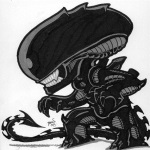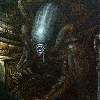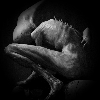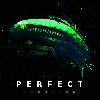The Perfect Organism
Ati
MemberPraetorianMar-21-2017 4:38 PMIs the xenomorph the winner?
The tardigrade, or water bear, is the single most incredible creature to have ever roamed the Earth. A tardigrade is a water-dwelling, microscopic animal with a segmented body and eight legs. They are nearly indestructible. They live and thrive on the most extreme places on the face of Earth, from the bottoms of the deepest, darkest, hottest trenches of the ocean, to the tops of the tallest and coldest mountains.

They can even survive being completely naked and exposed to the vacuum of space. Tardigrades can survive temperatures as high as 304 f and as low as -458 f. They can withstand pressures greater than 6000 times our own atmosphere, which is greater than the water pressure at the bottom of the Mariana Trench, the deepest part of the ocean. There have been reports of these creatures surviving more than 120 years without water. They can withstand more than 1000 times as much radiation as humans can. They are highly to resistant many environmental chemicals and toxins. These creatures can survive in almost any environment. Similar creatures could very well exist on planets that we don’t even consider to be habitable. The more we learn of the incredible extremes that these little creatures can take, the more we realize that life is far more resilient than we could have ever imagined. Perhaps we must greatly expand our criteria for determining whether or not a planet could support life.
http://astronomyisgood.blogspot.hu/2016/02/are-we-alone-life-in-cosmos-unsolved.html
Apex_Predator
MemberFacehuggerMar-21-2017 5:04 PMRadiodurans would give tardis a run for their money.
At a bigger scale I would say the cockaroach takes it.
Want some candy?

Stan Winston (deceased)
MemberFacehuggerMar-21-2017 5:12 PMThe smart money is on radiodurans being the 'rust' on the surface of Europa.
One day we'll look back and laff at how silly we were to even think we were ever alone.

Starlogger
MemberChestbursterMar-21-2017 5:14 PM@Stan Winston
ANYONE who thinks we are "alone" in this vast Universe is an egocentric individual who thinks "we" are the center of the Universe. And stupid, on top of that.

Grinning & Dropping Linen
MemberFacehuggerMar-21-2017 5:27 PMIn reference to our search for planets that could support life we are basically using what supports life on earth as a measurement or a guide. Where most all life on earth needs water, sunlight and are carbon based.
now imagine a planet where all life of small and enormous sizes had the properties of such an organism as the tardigrades. Or what if somehow life developed on a planet and everything was a silicon based life forms and trey evolved over millions of years with silicon as their base . There are tons of examples of micro organisms existing on earth where no life should due to environmental or other conditions, in frozen ice, lava, bottom of marianAs trench in sulfur plumes etc etc. most of the extreme cases on earth are like the tardigrades and are micro organisms..... But just imagine a planet where life found a way to exist not using carbon or even any element found on earth, and this life wasn't just microscopic but large and like wildlife. Imagine the possibilities, there may be elements out there in the cosmos which we have no comprehension of that do not even exist in our solar system, some exotic element that life can be built upon that is truly "alien", I fear we would have no understanding of such life forms whether they be sentient or just wildlife.
in the novel by Michael Crighton Sphere, there are a couple of great conversational exchanges between the books characters about life in the universe and our understanding of what they can be. I can't remember the exact dialog but the idea is when we imagine alien life we base it on something on earth even if it is strange or alien in appearance, such as 4 legged creatures with teeth or humanoid monstrosities, but the novel Sphere suggests in one of their conversations that this life may be something that we can't even imagine, it could be undetectable by us, undefinable, invisible, hell it could be a sentient gas cloud or look like sunlight or appear to not exist by our definitions but yet still be there unknown to us. Anyway I love this conversation piece about life out there.... Good stuff and great topics bringing up the resilient tardigrades.

Grinning & Dropping Linen
MemberFacehuggerMar-22-2017 11:11 AM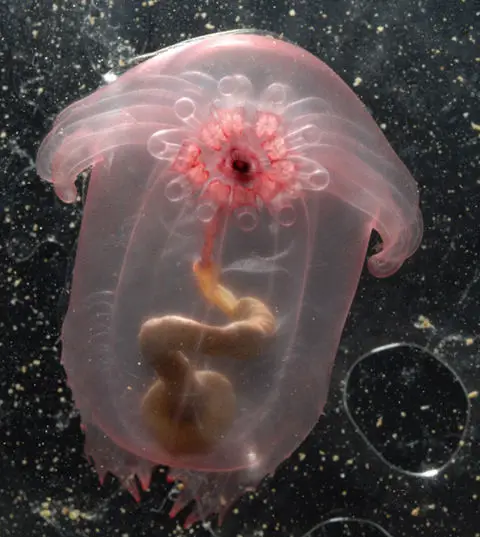
Something like this in space or even weirder and hostile, except this lives deep in the ocean on out planet, really the possibilities out there are limitless due to mainly not knowing what is exactly out there, all we have for comparison is life as we know it, but some unknown ecosystem or some bizarre yet discovered cosmic element that doesnt exist in our solar system could be the basis of life forms in a way that the human mind is not ready for...love science and possibilities of all of this.
Ati
MemberPraetorianMar-22-2017 11:18 AMGrinning..., thanks, I think the tardigrades' nose/mouth looks very biomecha. :D
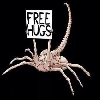
Rick
MemberXenomorphMar-22-2017 11:42 AMImmortal Jellyfish
The good news is that you can be immortal. The bad news is that you have to become a floating blob of jelly to do so. Scientists have discovered a jellyfish which can live forever.
Turritopsis dohrnii is now officially known as the only immortal creature. The secret to eternal life, as it turns out, is not just living a really, really long time. It’s all about maturity, or rather, the lack of it. The immortal jellyfish (as it is better known popularly) propagate and then, faced with the normal career path of dying, they opt instead to revert to a sexually immature stage.
Turritopsis rubra – Commonly confused with immortal jellyfish
(c) Photo Credit: Peter Schuchert/The Hydrozoa Directory
It turns out that once the adult form of the 4.5 mm-wide species Turritopsis dohrnii have reproduced, they don’t die but transform themselves back into their juvenile polyp state. Their tentacles retract, their bodies shrink, and they sink to the ocean floor and start the cycle all over again. Among laboratory samples, all the adult Turritopsis observed regularly undergo this change. And not just once: they can do it over and over again.
Thus, the only known way they can die is if they get consumed by another fish or if a disease strikes the jelly. However, there are still many mysteries surrounding the turritopsis dohrnii. While the process of reverting from its adult-phase to a polyp was observed several times, it hasn’t been observed yet in nature, only in laboratory environments.
Turritopsis nutricula vs Turritopsis rubra vs Turritopsis dohrnii
There was a lot of confusion even inside the scientific community between the three types of turritopsis jellyfish: the dohrnii, the nutricula and the rubra. Simply put, the turritopsis genus can be found in many parts of the world and it it is not an easy task to differentiate between these tiny jellyfishes.
The nutricula was for a long time mistakenly the one referred to as the immortal jellyfish, while the jellyfish used in the lab observations was the turritopsis dohrnii, as they were collected from the Mediterranean, where the dohrnii is found.
The nutricula is found in the Caribbean and North America and the cycle reversal was not in fact observed on the nutricula. That doesn’t mean that the nutricula isn’t biologically immortal but that it has not yet been observed and proven that. When the study (Bavestrello et al. 1992;
Piraino et al. 1996, 2004) was published, the difference between the dohrnii and nutricula wasn’t clear yet and afterwards the media distributed the information that the nutricula would be the immortal one.
And finally the rubra is a turritopsis that can be found next to New Zealand waters. Its photos can be found all over the web describing the nutricula, but the rubra wasn’t even observed to be immortal. Its shape is similar to that of the nutricula, but it is bigger (it can reach 7 mm versus the 4.5 mm of the nutricula).
So chances are that if you ever hear about the nutricula being immortal, it is in fact the dohrnii but a picture of a rubra will be attached.
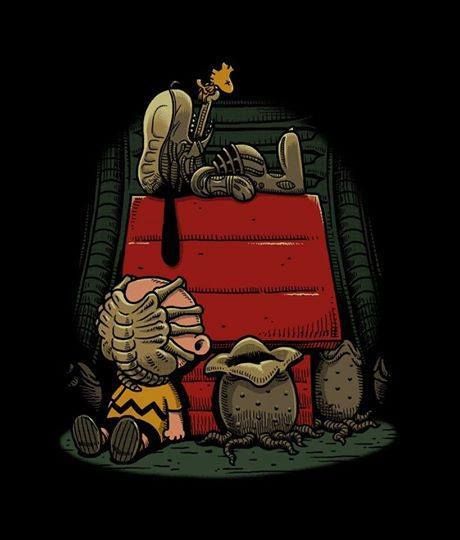

Grinning & Dropping Linen
MemberFacehuggerMar-22-2017 12:07 PM@Rick
Thanks for that about the immortal jellyfish ..Cool info, another awesome example of bizarre lifeforms
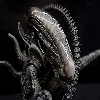
Parkerparrot
MemberFacehuggerMar-22-2017 1:46 PM@Rick
Heres another interesting little fellow...
Bdelloids are a type of microscopic organism that live in fresh water, yet can survive out of water for years. And if that's not weird enough, as a species they haven't had sex in about 80 million years.
We know what you're wondering: How do they keep their genetic material fresh, then? By stealing it from other animals, offcourse!
A lot of scientists are of the idea that a species can't survive long by reproducing asexually, since they end up becoming more flawed with each generation, like microscopic hillbillies. Bdelloids have defied those odds in the most horrifying way possible. When they analyzed the little bastards' DNA, scientists found it to be a "genetic mosaic" -- a single bdelloid had DNA from more than 500 different species.
Apparently, when they need to add some alien DNA to the gene soup, they just find whatever is lying around and attach it to their own broken double helix. This includes bits from near-by dead animals, from any food they hadn't gotten around to eating yet, and from who knows what else.
I find the part of not having sex for 80 million years quite depressing...
"Bees have hives, man"

Grinning & Dropping Linen
MemberFacehuggerMar-22-2017 2:01 PM@Parkerparrot
Awesome, the bedelloids sound like a low rent version of the Thing, where it takes DNA from other lifeforms, luckily for us it cant manipulate those life forms or mutate into them like the creature in John Carpenters films....but the fact that it takes DNA from other organisms is freaky and another score for fact is often stranger than fiction
p.s. I agree 80 million years is quite a long while and very sad, not sure if there is enough ice chips in the cosmos to deal with that lol

Parkerparrot
MemberFacehuggerMar-22-2017 2:24 PM@Grinning & Dropping linen
Ha ha!! I totaly agree!!!
"Bees have hives, man"











